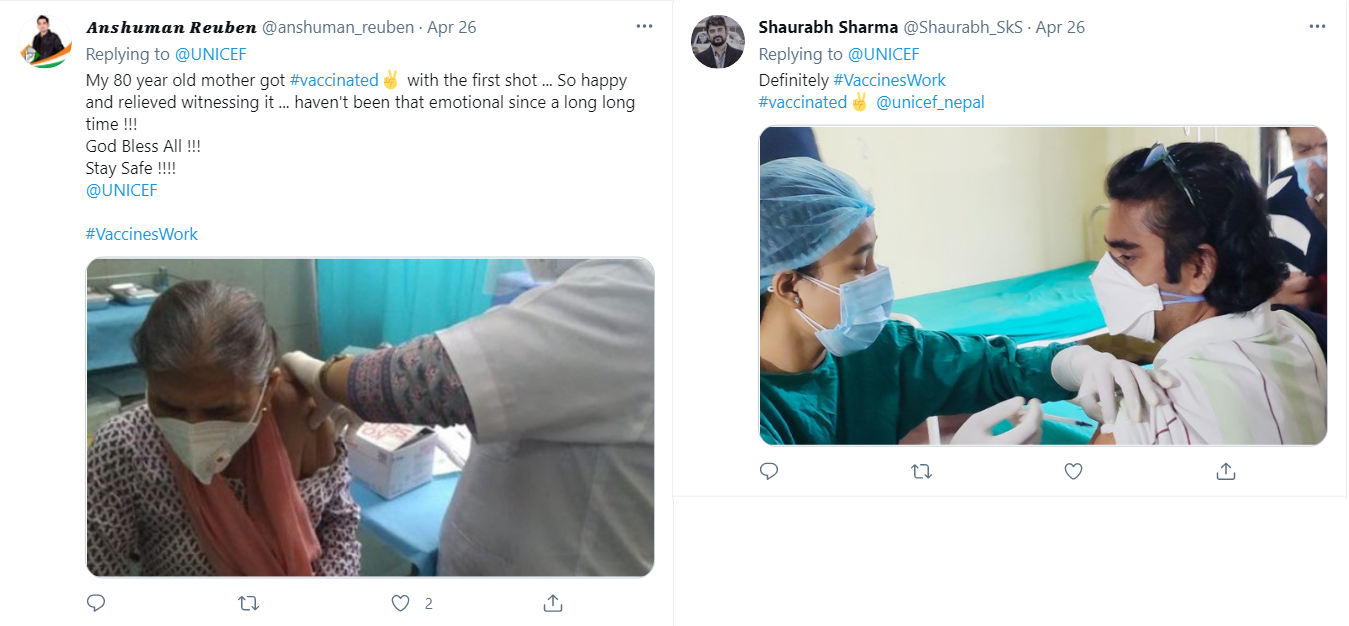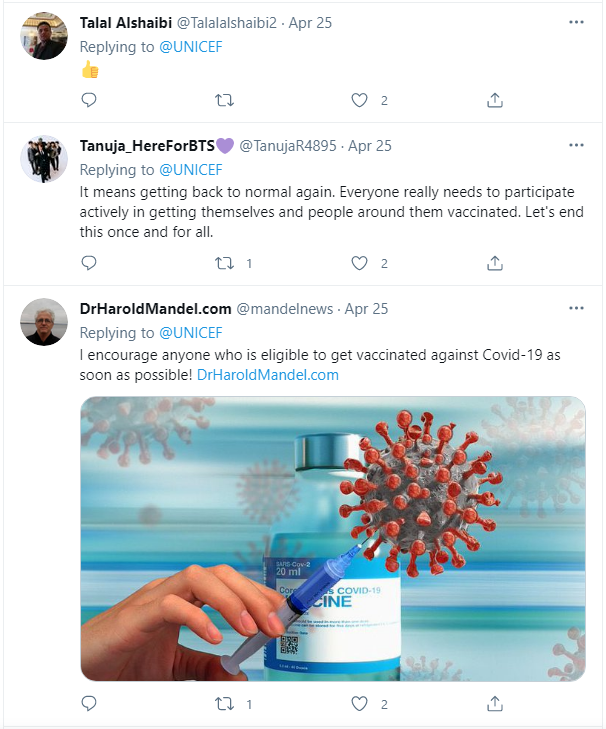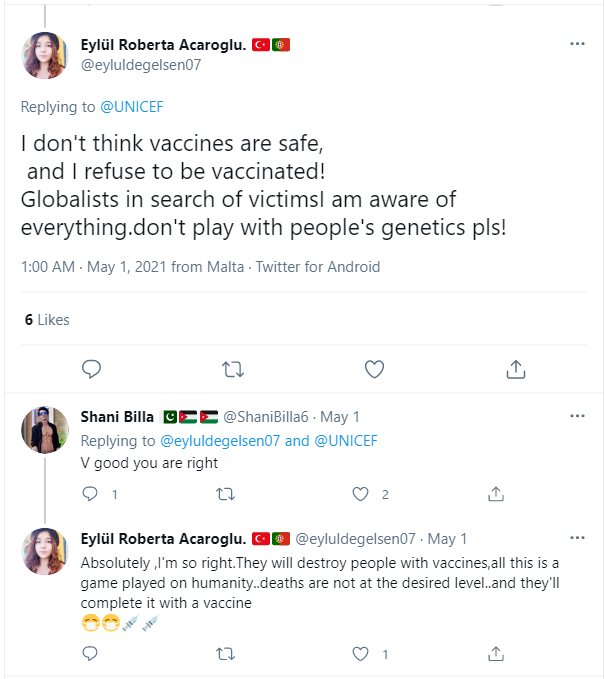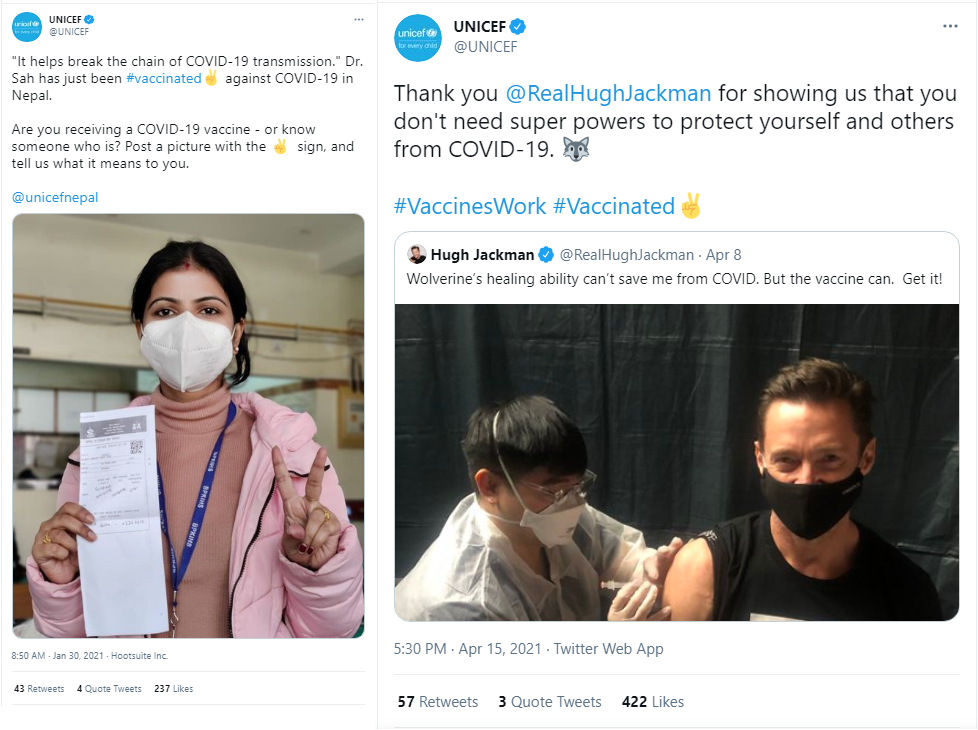Introduction
Public relations aim to create a positive image of the organization and, through the change in public attitudes, help the organization achieve its objectives. One instrument of public relations is campaigns. A campaign is a planned sequence of communication activities carried out over a specified period of time and designed to meet goals related to a particular issue (Sutherland, 2019b). One type of campaign is a change campaign intended to alter the state of a particular group, issue, or cause (Sutherland, 2019b). This paper aims to describe a recent change campaign conducted by United Nations Children’s Emergency Fund (UNICEF), a not-for-profit, non-governmental organization. UNICEF’s campaign is called #Vaccinated, and it was launched in January 2021. Further, the purpose and the effectiveness of the campaign will be discussed in relation to communication theories.
Campaign Description
The objective of UNICEF’s #Vaccinated campaign is to change public attitudes toward vaccination against COVID-19 and encourage people to get vaccinated. The organization informs the audience about its campaign on its website and social media accounts. As part of its campaign, UNICEF publishes educational videos on YouTube, explaining the benefits of vaccines and debunking myths about their harm. The organization encourages its audience’s engagement by asking them to help spread the information about the safety of the COVID-19 vaccine. It calls on people to take a photo of themselves with a “V-sign, plaster or vaccination card,” post it on social media and use the #Vaccinated hashtag and the @UNICEF tag for an opportunity to be featured (UNICEF, 2021b, para. 5). The campaign received positive feedback and engagement from the audience.
The Assessment of the Campaign’s Success
UNICEF’s #Vaccinated campaign can be considered successful because it caused the expected public engagement on various social media platforms. Further, the campaign’s effectiveness on Twitter will be explored. UNICEF used the technique of storytelling to persuade its audience of the necessity and safety of vaccination. The organization posted videos of people narrating their experience of vaccination, photos, and stories of its own contributions to vaccinating individuals. Creating stories about the organization is one of the main purposes of public relations because stories are memorable and motivate the public to share them with others (Freberg, 2020). UNICEF successfully used the compact format of tweets to conveying concise but effective messages to its audience.
The #Vaccinated campaign seems to fall under the dialogic public relations theory. According to this theory, organizations should be involved in ethical and honest two-way communication with the public (Sutherland, 2019a). UNICEF managed to establish such communication with its audience, which is evidenced by people’s replies in support of the organization’s campaign shown in Figure 1.

The dialogic theory involves the following components: mutuality, commitment, empathy, risk, and propinquity (Sutherland, 2019a). In the given campaign, mutuality is expressed by the organization’s and the public’s willingness to be connected. The organization connects to the audience with its tweets, and the audience connects to the organization by liking, sharing, and commenting on posts. For example, in Figure 2, the simple comment by Talal Alshaibi represents his willingness to connect to UNICEF. Commitment and empathy are also present, evidenced by comments in Figure 2, in which the audience shows commitment to conversation and supportiveness. Propinquity is demonstrated by UNICEF’s continuous engagement with its audience since it constantly publishes new tweets and sometimes features the audience’s stories, which motivates people to support the campaign.

Finally, the risk that the dialogue will unfold unpredictably is also present. For example, one of the UNICEF’s tweets received a comment from a vaccine opponent (see Figure 3). This person’s feedback to the #Vaccinated campaign represents a theory of persuasion called social judgment theory. This theory explains how people assess persuasive messages and how their assessments influence whether they will be persuaded (Gass & Seiter, 2004). According to social judgment theory, an individual has an anchor point, that is, the preferred opinion on the spectrum between the extreme positions (Gass & Seiter, 2004). A person’s anchor point determines his or her latitude of acceptance and latitude of rejection, that is, what other opinions this person can accept (Gass & Seiter, 2004). It is clear that the anchor point of the commentator in Figure 3 is in the extreme position because she strongly opposes vaccination. As per social judgment theory, UNICEF’s campaign does not have the persuasion power to convince strong opponents of the necessity and safety of vaccination.

As for the theories of change campaigns, the #Vaccinated campaign falls under the rhetorical theory. This theory consists of three components: ethos (appeal to trust and authority), logos (appeal to logic and reasoning), and pathos (appeal to emotions and beliefs) (Sutherland, 2019b). Figure 4 demonstrates UNICEF’s use of ethos since the organization persuades its audience by showing the trustworthy and credible individuals (a doctor and a famous star Hugh Jackman) undergoing vaccination. The audience’s engagement with these tweets is demonstrated by retweets, likes, and comments, which proves their effectiveness. UNICEF’s use of pathos involves posting stories and photos of vaccinated people on Twitter. Finally, logos is mainly used on UNICEF’s website rather than social media. On its website, the organization publishes articles proving vaccines’ safety.

Possible Improvements
Overall, UNICEF’s #Vaccinated campaign is successful because it has reached its goal of motivating people to vaccinate and spread the information about the necessity of vaccination against COVID-19. The organization’s social media publications possess the qualities of effective messages: consistency, strong voice, and authenticity (Freberg, 2020). The message is consistent with UNICEF’s image of an organization caring for people’s well-being worldwide. The organization uses a credible but friendly tone associated with the brand. Finally, the message does not feel artificially created because it aligns with organizational humanitarian purposes.
One of the best practices for creating social media content is constantly tracking the audience’s reaction to publications and adjust the content plan accordingly (Freberg, 2020). Given this practice, UNICEF could improve its campaign by posting more tweets featuring vaccinated celebrities. As Figure 4 shows, such posts result in an increased public engagement, manifested by retweets and likes. People’s sharing of the information is one of the main goals of the #Vaccinated campaign, so additional retweets would be beneficial for the success of the campaign. Furthermore, featuring celebrities would serve as an appeal to ethos and contribute to the persuasiveness of the organization’s message.
The Significance of Social Media in Relation to Other Communication Approaches
UNICEF promotes vaccination not only on social media, which include Twitter, Facebook, YouTube, and Instagram, but also via its website and traditional media, such as TV and print media. However, the #Vaccination campaign is designed particularly for social media because it requires the involvement of the public. According to Weaver (2018), social media have eliminated the economic barriers to and journalistic dominance over media, which has given activists broad access to audiences. In addition, social media have allowed for a co-creation of the relationships between the organization and the public and cooperative development of solutions to issues (Weaver, 2018). Thus, social media have an advantage over traditional media since, in traditional media, the organization is mainly involved in one-way communication with its audience. The use of social media has enabled UNICEF to enlist public support to achieve its goal of encouraging and spreading information about vaccination.
Comparison of Campaigns
A similar change campaign was conducted by the National Association of Manufacturers (NAM). This organization’s campaign was called #ThisIsOurShot and aimed at encouraging manufacturers to undergo COVID-19 vaccination (NAM, 2021). Like UNICEF, NAM motivated its audience to spread the information about vaccination, but it used a different strategy. Instead of asking people to post photos, it requested companies to publish posts on their social media accounts with links to NAM’s website with information about vaccines. Like UNICEF, this organization used different types of appeals for persuasion: ethos, when referring to CDC’s approval of the vaccine; pathos, when calling on people to get vaccinated to “get back moments we miss;” and logos, when citing safety data and clinical trials (NAM, 2021). In comparing these two change campaigns, one can refer to the framing theory. According to it, public relationships specialists should frame an issue in a way that resonates with the audience and fits into the existing media frame (Stanton, 2007). Thus, UNICEF framed the issue of vaccination in terms of the general public, while NAM adjusted its message to employers’ interests.
Conclusion
Social media are a powerful instrument for public relations specialists to change people’s attitudes toward a particular issue and achieve the audience’s engagement. The reviewed UNICEF’s #Vaccinated campaign can be considered successful because it helped the organization achieve its goal of making people vaccinate and share their vaccination experiences with others. UNICEF achieved its goal by using persuasive techniques and aligning its message with organizational objectives.
References
Acaroglu, E. R. (2021). I don’t think vaccines are safe. Web.
Freberg, K. (2020). Discovering public relations: An introduction to creative and strategic practices. Los Angeles, CA: Sage.
Gass, R. H., & Seiter, J. S. (2004). Theorizing about persuasion. In R. H. Gass & J. S. Seiter (Eds.), Perspectives on persuasion, social influence, and compliance gaining (pp. 45-64). Boston, MA: Pearson.
The National Association of Manufacturers [NAM]. (2021). Social media toolkit. Web.
Stanton, R. (2007). Media relations. Melbourne, Australia: Oxford University Press.
Sutherland, K. (2019a). Building relationships with audiences, publics and stakeholders: Public relations as a people-centered practice. In K. Sutherland, S. Ali, & U. Khattab (Eds.), Public relations and strategic communication (pp. 1-38). Melbourne, Australia: Oxford University Press.
Sutherland, K. (2019b). Change campaigns: Public opinion and inspiration. In K. Sutherland, S. Ali, & U. Khattab (Eds.), Public relations and strategic communication (pp. 1-31). Melbourne, Australia: Oxford University Press.
Weaver, C. K. (2018). The slow conflation of public relations and activism: Understanding trajectories in public relations theorising. In A. Adi (Ed.), Protest public relations: Communicating dissent and activism (pp. 12-28). New York, NY: Routledge.
UNICEF [UNICEF]. (2021a). Getting a COVID-19 vaccine? Post a selfie, tell us what being #vaccinated means to you and tag @UNICEF for the chance to be featured. Web.
UNICEF. (2021b). #Vaccinated. Web.